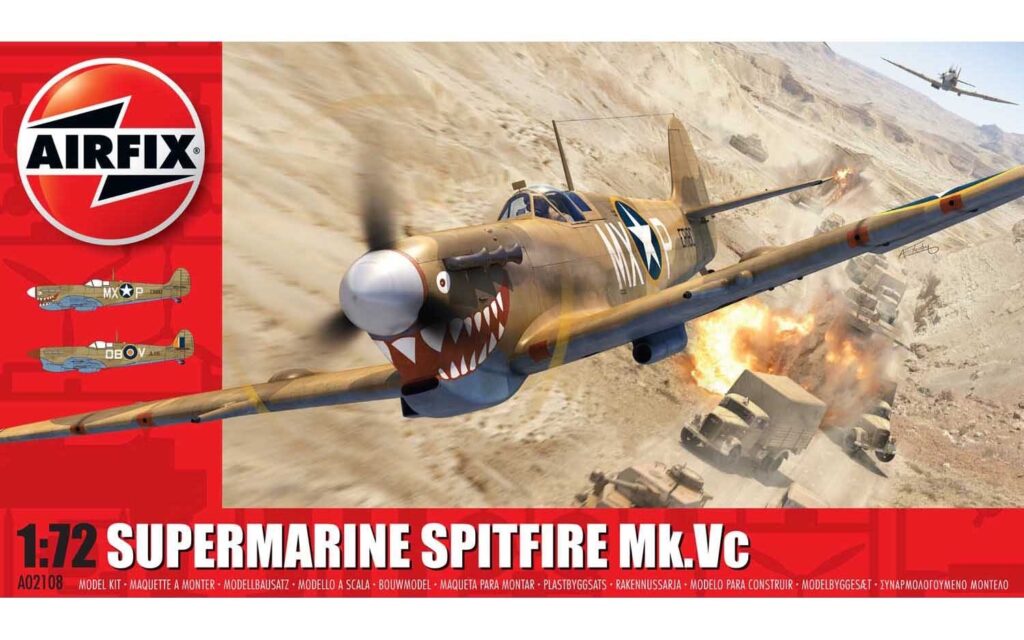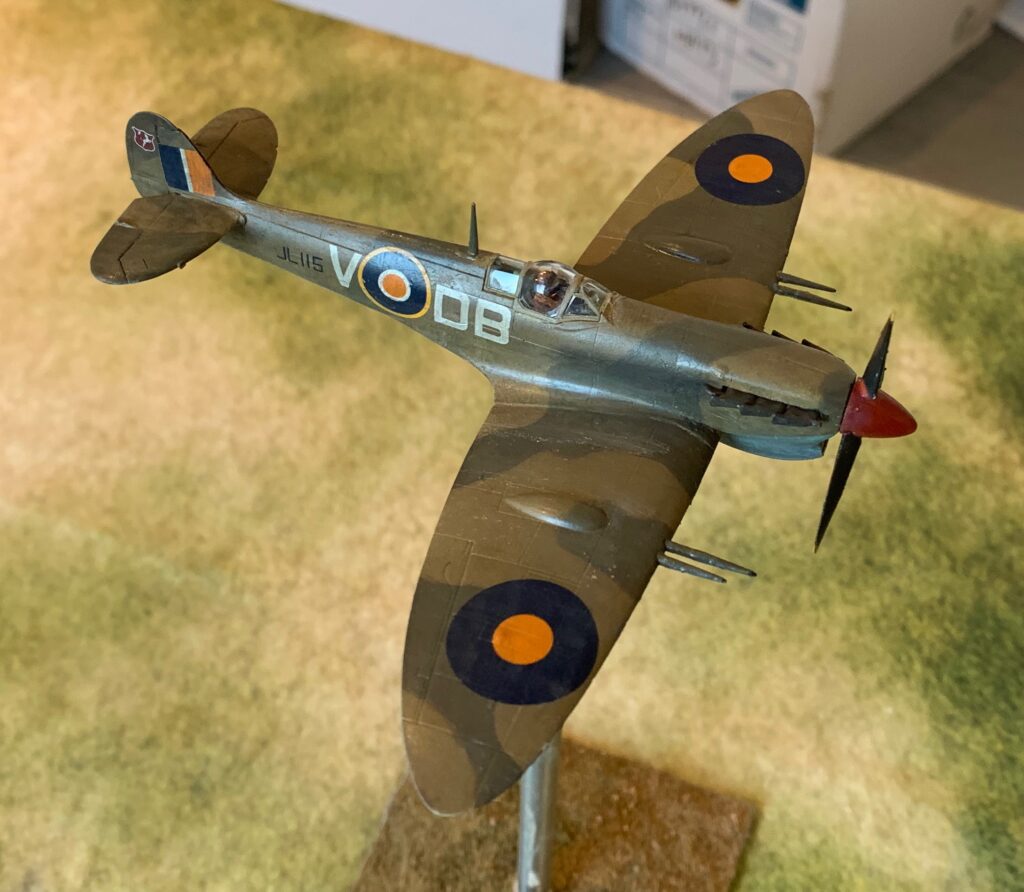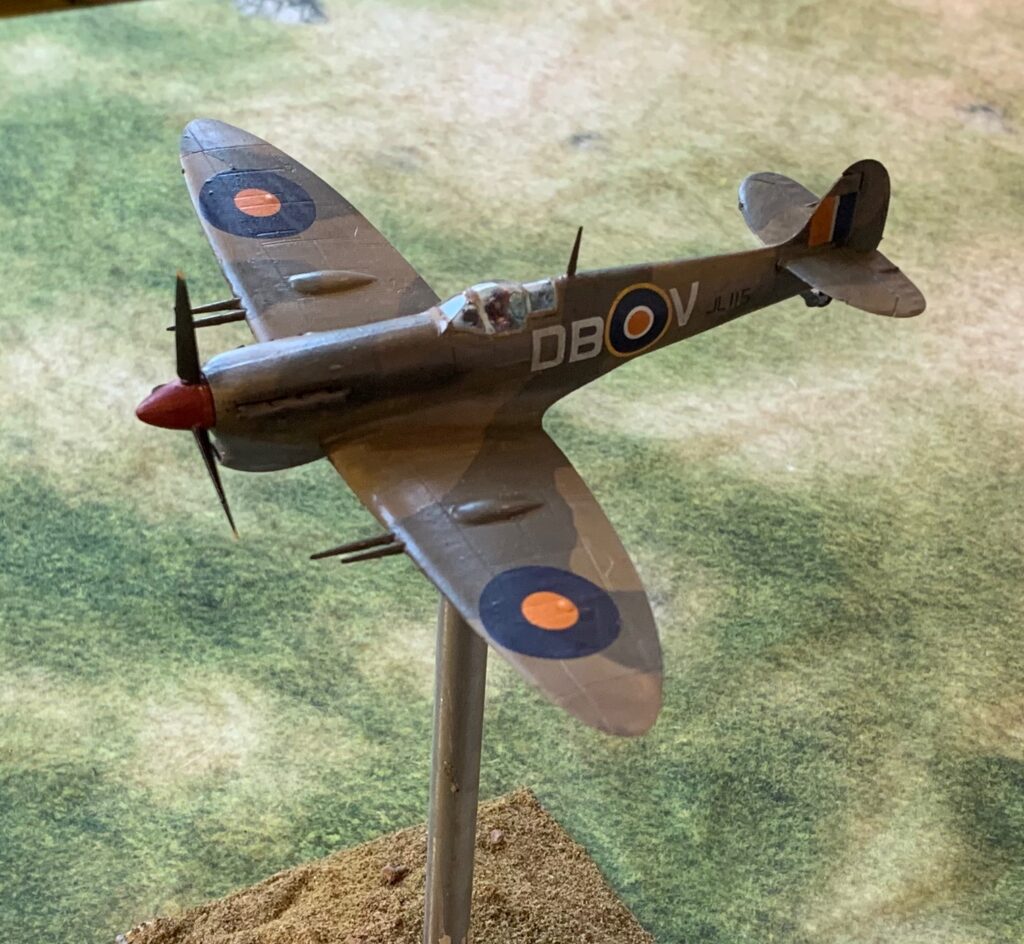
And the last but by no means least of my trio British planes is the Spitfire VC, which I built from the Airfix kit, released last year. Airfix was my favourite manufacturer back in the day – but this is my first Airfix kit on my return to modelling. In fact the prospect of this model’s release that was one of the things that prompted this project.
The Spitfire V, in the tropical version with the Vokes filter, was backbone of the RAF (and other Commonwealth air forces’) effort in 1943 in the Mediterranean theatre. It started the year as the main air-superiority fighter – although it was considered to be a bit behind the Messerschmitt Bf 109G and the Focke-Wolf Fw190A then use by the Luftwaffe, it was still the best the Allies had. As the year progressed the Luftwaffe was overwhelmed, and the Spitfire VIII and IX came in, with an upgraded Merlin engine. The Fw-190, considered its best German fighter, was withdrawn from the air-superiority role in this theatre, though still used as a fighter-bomber. The Bf-109Gs were increasingly manned by raw and overworked pilots. The Spitfire V iwas needed less as a pure fighter and took up a role as fighter-bomber (the “Spitbomber”), which is how I wanted my model.
The A,B and C designations of the Spitfire V referred to the wing. The A wing was that used on the Spitfire Is in the Battle of Britain, with four .303 machine-guns on each wing. The B wing replaced two of the machine-guns with a 20mm cannon, including a blister on the upper wing to house ammunition. The C wing was generally improved, and could be configured with 4 machine-guns (which almost never happened), one cannon and two machine-guns (the typical configuration) or two cannon (quite unusual apparently – but what my model shows). The C-wing became standard for later marks. The VC was the most common version in the Mediterranean theatre, I believe – though there were quite few VBs earlier on.
In common with the other models in this batch, I decided to use the box decals. These depict either a US-operated aircraft from early 1943, or one from 3 Squadron of the South African Air Force, dated in the blurb at November. This was a bit late for my purposes – but a bit of research showed that the aircraft went into service with 3 Squadron in early July – just before the Sicily campaign – which was fine. These planes had the unusual four cannon armament, which added interest. Doubtless this reflected its fighter-bomber role. Here is a picture of the plane in service (it is DB-V):

The Airfix kit is excellent – and so it should be from something this recently released – and good value for money. As with standard Airfix practice, it can be made with undercarriage up, and a pilot is provided – though not a very nice one (I put it in the Hurricane, where it was less visible, and where I needed a smaller figure). I have only one real gripe with Airfix, apart from wanting them to make a better effort with the pilot: they did not provide any bombs. Since all the photos I have seen of the 3 Squadron machines show them carrying bombs, and since the box artwork shows the American plane on a bombing mission (though actually I don’t think Spits were used in this role until Sicily), this is a bit of a gap. They do provide parts for a clipped-wing version, for a plane without the Vokes filter, and even for under-belly slipper fuel tank, however. Fortunately I had spotted that my Eduard Spitfire VIII had parts for two underwing bombs, which I had no plans to use. The 3 Squadron pictures show the planes carrying a single bomb under the fuselage – but I think earlier on underwing bombs were standard – and I think the central bomb-rack was not developed until after Sicily at least, and possibly not until a lot later(there was a need to make sure the bomb was thrown clear of the propellor in dive-bombing missions, I think). My reference for the original bomb racks suggested that they were pretty much invisible after the bombs were released – which fits with the Eduard parts (and not photos I think from 1944 which show substantial pylons).
I digress. here is the finished model:



I think this is the best of my three models. As with the Kittyhawk I had a bit of trouble with the fit of the fuselage to the wings, but in the end result this doesn’t show badly. One of the underwing roundels isn’t quite flat. The colour scheme is awry, but an interesting point from the photo is that the underside is quite pale on these planes. Usually the Azure Blue is darker than the Mid Stone, but in this case it is plainly lighter – on the two further aircraft anyway. So even here my model may not be as awry as the others. Another curiosity is that the red on the roundels in the decals is very pale, orange actually – and not the typical dark red. This is possibly consistent with the foreground plane in the photo, and the tail flash of DBV. I decided to rely on Airfix’s research and use them anyway. Perhaps it is an SAAF thing?
Rather remarkably, this is the first Spitfire model I have made. I had previously made a P-47, Bf-109, Fw-190, Stuka, Hurricane and Kittyhawk – so this is the first breaking of new ground in my project. It is a lovely aircraft, even with the Vokes filter. I am looking forward to my Mark VIII later in the project, which is even sleeker. I am minded to attempt a VB, or perhaps another VC, from the Tunisia period, in air-superiority mode. But not until the plastic mountain comes down a bit more. There are still eight more planes in it! To say nothing of the vehicles.
Thanks for an interesting review and background info. Yes, orange roundel and fin flash colours was a South African thing and imo adds a welcome bit of variety.
Thanks Chris.